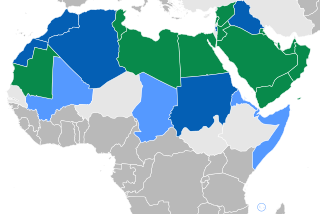
Arabic is a Central Semitic language of the Afroasiatic language family spoken primarily in the Arab world. The ISO assigns language codes to 32 varieties of Arabic, including its standard form of Literary Arabic, known as Modern Standard Arabic, which is derived from Classical Arabic. This distinction exists primarily among Western linguists; Arabic speakers themselves generally do not distinguish between Modern Standard Arabic and Classical Arabic, but rather refer to both as al-ʿarabiyyatu l-fuṣḥā or simply al-fuṣḥā (اَلْفُصْحَىٰ).

Hausa is a Chadic language that is spoken by the Hausa people in the northern parts of Nigeria, Ghana, Cameroon, Benin and Togo, and the southern parts of Niger, and Chad, with significant minorities in Ivory Coast. A small number of speakers also exist in Sudan.
The Nubian languages are a group of related languages spoken by the Nubians. In the past, Nubian languages were spoken throughout much of Sudan, but as a result of Arabization they are today mostly limited to the Nile Valley between Aswan and Al Dabbah. In the 1956 Census of Sudan there were 167,831 speakers of Nubian languages. Nubian is not to be confused with the various Nuba languages spoken in villages in the Nuba mountains and Darfur.

Gulf Arabic is a variety of the Arabic language spoken in Eastern Arabia around the coasts of the Persian Gulf in Kuwait, Bahrain, Qatar, the United Arab Emirates, southern Iraq, eastern Saudi Arabia, northern Oman, and by some Iranian Arabs.
Masalit is a Nilo-Saharan language of the Maban language group spoken by the Masalit people in West Darfur, Sudan and Ouaddaï Region, Chad.

Shina is a Dardic language of Indo-Aryan language family spoken by the Shina people. In Pakistan, Shina is the major language in Gilgit-Baltistan spoken by an estimated 1,146,000 people living mainly in Gilgit-Baltistan and Kohistan. A small community of Shina speakers is also found in India, in the Guraiz valley of Jammu and Kashmir and in Dras valley of Ladakh. Outliers of Shina language such as Brokskat are found in Ladakh, Kundal Shahi in Azad Kashmir, Palula and Sawi in Chitral, Ushojo in the Swat Valley and Kalkoti in Dir.
Dinka is a Nilotic dialect cluster spoken by the Dinka people, a major ethnic group of South Sudan. There are several main varieties, such as Padang, Rek, Agaar, Ciec, Apaak, Aliab, Bor, Hol, Nyarweng, Twic Bor and Twic Mayardit, which are distinct enough to require separate literary standards. Jaang, Jieng or Muonyjieng is used as a general term to cover all Dinka languages. Recently Akutmɛ̈t Latueŋ Thuɔŋjäŋ has proposed a unified written grammar of Dinka.
Maninka, or more precisely Eastern Maninka, is the name of several closely related languages and dialects of the southeastern Manding subgroup of the Mande language family. It is the mother tongue of the Malinké people in Guinea, where it is spoken by 3.1 million people and is the main language in the Upper Guinea region, and in Mali, where the closely related Bambara is a national language, as well as in Liberia, Senegal, Sierra Leone and Ivory Coast, where it has no official status. It was the language of court and government during the Mali Empire.
Zaghawa is a Nilo-Saharan language spoken by the Zaghawa people of east-central Chad and northwestern Sudan (Darfur). The people who speak this language call it Beria, from Beri, the endonym of the Zaghawa people, and a, Zaghawa for "mouth". It has been estimated that there are about 447,400 native speakers of the Zaghawa language, who primarily live in Chad and the Darfur region of Sudan. It is also spoken by a smaller number of speakers in Libya.

Ṣaʽīdi Arabic, or Upper Egyptian Arabic, is a variety of Arabic spoken by the Upper Egyptians in the area that is South/Upper Egypt, a strip of land on both sides of the Nile that extends from Aswan and downriver (northwards) to Lower Egypt. It shares linguistic features with Egyptian Arabic, Modern Standard Arabic, and the Classical Arabic of the Quran. Dialects include Middle and Upper Egyptian Arabic.
Dongolawi is a Nubian language of northern Sudan. It is spoken by a minority of the Danagla people in the Nile Valley, from roughly upstream to the bend in the Nile near ed Debba. Dongolawi is an Arabic term based on the town of Old Dongola, the centre of the historic Christian kingdom of Makuria. Today's Dongola was founded during the 19th century on the western side of the Nile. The Dongolawi call their language Andaandi "the language of our home".

S’gaw, S'gaw Karen, or S’gaw K’Nyaw, commonly known as Karen, is a Sino-Tibetan language spoken by the S'gaw Karen people of Myanmar and Thailand. A Karenic branch of the Sino-Tibetan language family, S'gaw Karen is spoken by over 2 million people in Tanintharyi Region, Ayeyarwady Region, Yangon Region, and Bago Region in Myanmar, and about 200,000 in northern and western Thailand along the border near Kayin State. It is written using the S'gaw Karen alphabet, derived from the Burmese script, although a Latin-based script is also in use among the S'gaw Karen in northwestern Thailand.
Midob is a Nubian language spoken by the Midob people of North Darfur region of Sudan. As a Nubian language, it is part of the wider Nilo-Saharan language family.
Afitti is a language spoken on the eastern side of Jebel el-Dair, a solitary rock formation in the North Kordofan province of Sudan. Although the term ‘Dinik’ can be used to designate the language regardless of cultural affiliation, people in the villages of the region readily recognize the terms ‘Ditti’ and ‘Afitti.’ There are approximately 4,000 speakers of the Afitti language and its closest linguistic neighbor is the Nyimang language, spoken west of Jebel el-Dair in the Nuba Mountains of the South Kordofan province of Sudan.
The Hill Nubian languages, also called Kordofan Nubian, are a dialect continuum of Nubian languages spoken by the Hill Nubians in the northern Nuba Mountains of Sudan.
Kadaru is a Hill Nubian language spoken in the northern Nuba Mountains in the south of Sudan. It is spoken by around 25,000 people in the Jibaal as-Sitta hills, between Dilling and Delami. Kordofan Nubian is a cluster of dialects also called Ajang Language with names of dialects varying according to specific clans. According to Ajang people, they all belong to one language group and although some sounds and words might have changed with time, they can understand each other quite well. It is closely related to Ghulfan, with which it forms the Kadaru-Ghulfan subgroup of Hill Nubian.
Wali is a Hill Nubian language spoken in the northwestern Nuba Mountains in the south of Sudan. It is spoken by around 9,000 people 12 km northeast of Katla. Ethnologue reports that use of Wali is vigorous and that there are many monolingual speakers. Young children speak English and Wali, but it is expected that the next generation will continue to communicate using Wali.
Bori is a Tani language of India. Bori is spoken in Payum Circle, West Siang District, Arunachal Pradesh.
Iranian Persian, Western Persian or Western Farsi, natively simply known as Persian, refers to the varieties of the Persian language spoken in Iran and by minorities in neighboring countries, as well as by Iranian communities throughout the world. These are mutually intelligible with other varieties of Persian, including Afghanistan's Dari and Tajikistan's Tajiki.
Gumuz is a dialect cluster spoken along the border of Ethiopia and Sudan. It has been tentatively classified within the Nilo-Saharan family. Most Ethiopian speakers live in Kamashi Zone and Metekel Zone of the Benishangul-Gumuz Region, although a group of 1,000 reportedly live outside the town of Welkite. The Sudanese speakers live in the area east of Er Roseires, around Famaka and Fazoglo on the Blue Nile, extending north along the border. Dimmendaal et al. (2019) suspect that the poorly attested varieties spoken along the river constitute a distinct language, Kadallu.






